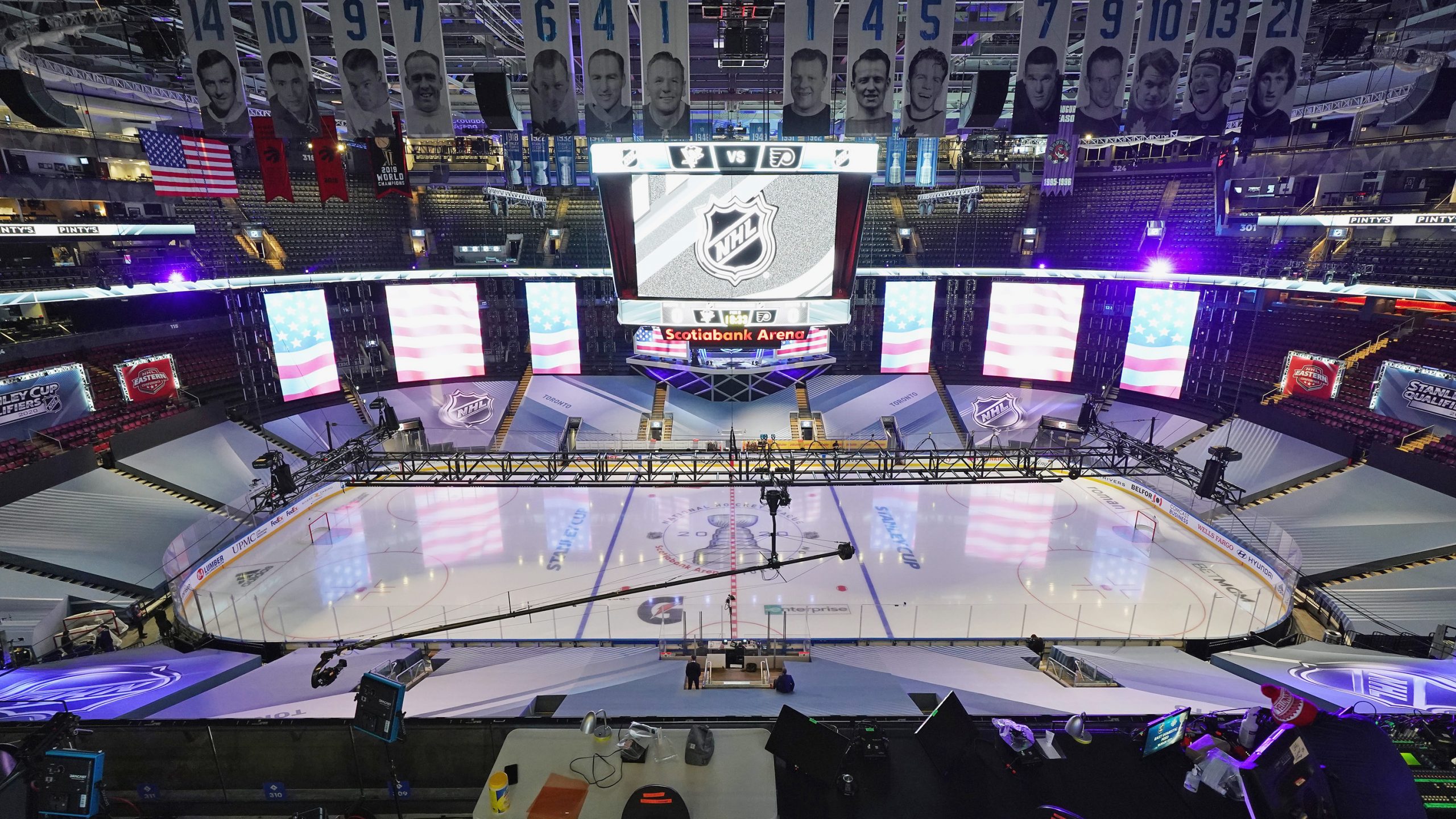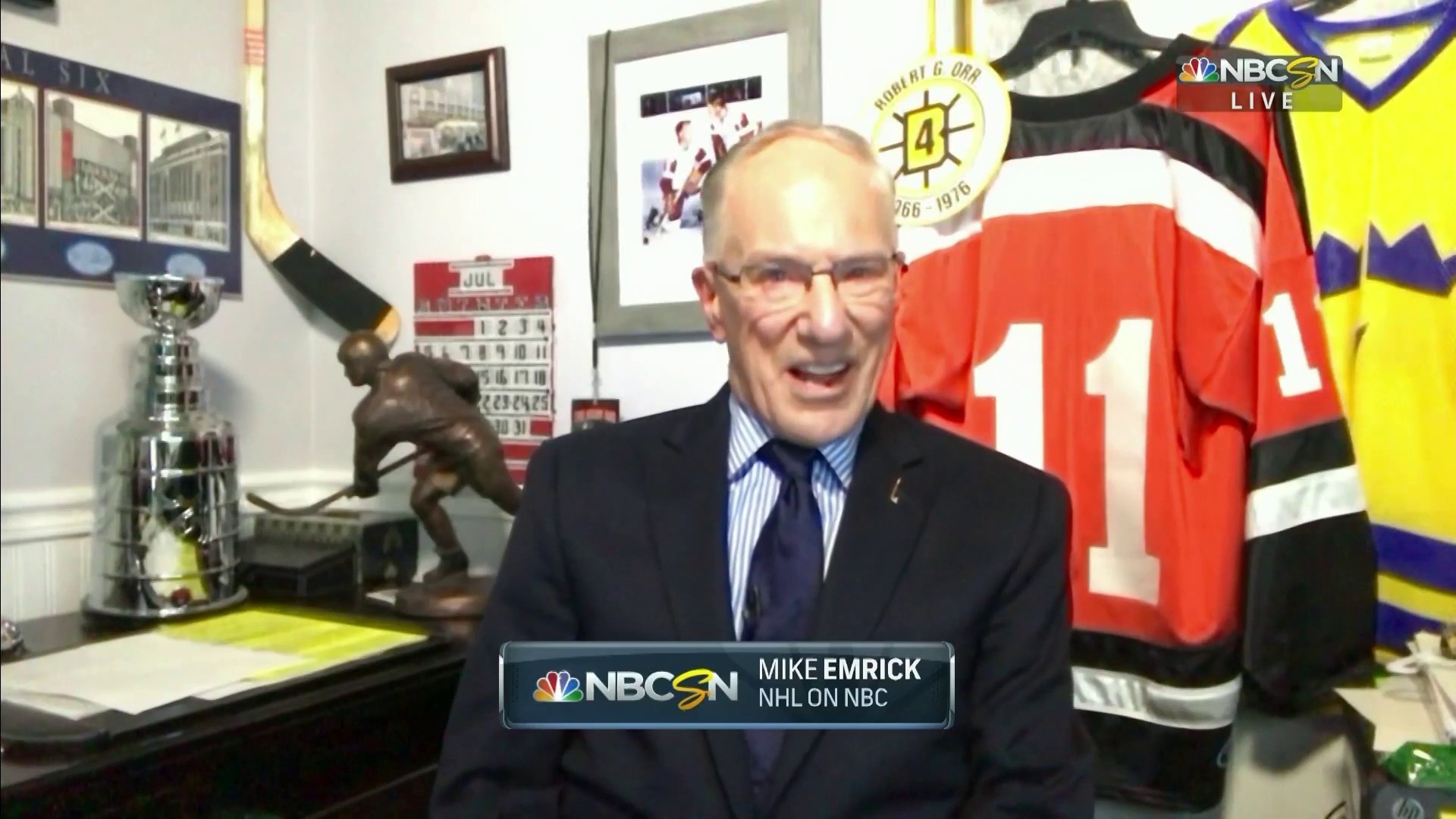NHL Returns: League, NBC Sports, Rogers SportsNet Ready Made-for-TV Product as Quest for Stanley Cup Resumes
With no fans, broadcast partners take creative live-television risks on host-feed productions
Story Highlights
It has been a big week for “bubbles” in the sports-television world. The NWSL successfully completed its Challenge Cup. The MLS Is Back Tournament is rolling along COVID-free. And the NBA enjoyed a triumphant return on Thursday evening.
Now it’s the NHL’s turn. The league returns to action on Saturday with a slate of five “Qualifying Round” games, beginning with the New York Rangers facing the Carolina Hurricanes (noon ET, NBCSN, Fox Sports Carolina, MSG Network, NHL.TV, Sportsnet).

Scotiabank Arena prior to a Pittsburgh Penguins–Philadelphia Flyers exhibition game before the start of the 2020 NHL Stanley Cup Playoffs. (Photo: Andre Ringuette/Freestyle Photo/Getty Images)
NHL has built two “Hub Cities” in Toronto (Scotiabank Arena) and Edmonton (Rogers Place), redesigning each to look more like the set of an American Gladiators-esque game show than a pro-hockey game.
The bubbles have, so far, done what they were designed to do: offer a safe, COVID-free environment for sports to be played. However, these controlled environments are also serving as laboratories for live sports-video production. The NHL sees that and has built a truly made-for-television product for fans watching at home.
Working with Canadian broadcaster Rogers Sportsnet in Edmonton and U.S. broadcaster NBC Sports in Toronto, the league has built similar broadcast templates that include deployment of more than 30 cameras in each arena; a typical NHL game usually caps out around 20. Each broadcaster will be responsible for creating a world feed to be shared with each other and, when it applies, with the regional sports networks for the teams playing in the game.
“We think this will make for a compelling television product,” says NHL Commissioner Gary Bettman. “While there’s nothing better in person from a sporting standpoint than an NHL game — the energy, the noise, the excitement of our crowds may be irreplaceable from that standpoint — this is going to be made into a very entertaining and compelling experience.”
Trying New Things
Although it’s easy to focus on what the NHL is losing in these Hub Cities due to the coronavirus pandemic (one of the greatest draws of the Stanley Cup Playoffs are the raucous environment and the energy in sold-out arenas), the league has put a lot of energy into taking advantage of the things it would never be able to do with fans in the building.
That includes placing cameras, video screens, and microphones in locations that, normally, would obstruct the view of fans in the stands or would be a safety concern.
“We can go into stands and show people camera angles that they’ve never seen before,” says Steve Mayer, chief content officer and senior executive VP, events and entertainment, NHL. “We have no fans here, so we are able to walk around an arena and find the perfect, most ideal positions for every single one of our cameras. We think that, as we move through each game, we’re going to be able to do some things on the broadcast side that are unique, special, and much different than anything our audience has ever seen before.”
NHL Senior EVP and Chief Content Officer Steve Mayer gives a behind-the-scenes account of the Rogers Place design process. #StanleyCup pic.twitter.com/4Dc8Tsw5T5
— NHL (@NHL) July 28, 2020
“Steve and his group are extraordinarily creative,” says Bettman, a 2018 inductee of the Sports Broadcasting Hall of Fame.
“This will be something different for all of us to see,” adds Mayer, “but the focus will be on creating a terrific fan experience and connection through media.”
JITACAM Gets New Location
Leading up to this week’s restart, a lot has been made of the JITACAM that has been erected in each of the arenas. JITACAM is basically a jib on an extremely long crane arm that can operate in 360 degrees.
The system has been used on NHL broadcasts before, including during various All-Star Games and Stanley Cup Finals. However, whenever JITACAM has been used in the past, it has always been affixed to the bottom of the centerhung videoboard. That’s not the case in the bubbles. Instead, it is hung above the seats, a location normally unavailable for safety reasons and because of blocked viewing angles. The camera is on a truss and will dolly across the ice.
“We feel this is a camera that’s going to offer a very unique look,” says Mayer. “Plus, it’s going to be able to track along with our players and get an amazing feel for the speed of our game.”
“It can swoop in behind the power play,” says NBC Sports Executive Producer Sam Flood, “and there’s nothing better than to look at that top of the point position of a power play and looking in at the goalie, trying to figure out where the puck is going to go in the net. We think that it will be a unique way to look at a certain part of the game, and it will also be a fun camera to use in transition.”
Not All That New For NBC Sports
While the integrity of the bubble environments has been priority No. 1 for the league, broadcasters are compromising by not bringing all of their broadcast, production, and operations talent onsite.
In the U.S., that includes primary play-by-play announcer Mike “Doc” Emrick, who will begin the restart by calling games from a home studio in Michigan. According to The Athletic, NBC Sports VP, Studio Operations and Facilities, Tom Popple and Senior Operations Associate Sean Riley took a road trip with a minivan full of video equipment to visit the homes of both Emrick and analyst Eddie Olczyk to set up home studios for each sportscaster. With multiple screens, audio devices, and communications systems installed in their homes, both are in a position to call games without needing to leave home, forget crossing the border into Canada.
During a media conference call this week, Emrick and Flood noted that more broadcasters could be traveled into the bubbles as the Playoffs progress, but that will be decided on a day-to-day basis. Because Emrick is a cancer survivor over the age of 70, NBC Sports does not want to do anything that would remotely put him — or others — at risk.
In addition, NBC Sports will be leveraging its Stamford, CT, studios in a significant way, receiving the host-broadcast feed and adding much of its graphics, replay, and audio elements from control rooms there.
Although this is a completely new approach to the Stanley Cup Playoffs, this method of at-home production is familiar to NBC Sports, which has been producing Olympic events in a model similar to this for well more than a decade. Flood credits Dave Mazza, SVP/CTO, NBC Sports Group and NBC Olympics and his team for playing a crucial role in bringing many of the templates of these at-home methods
Artificial Crowd Noise and a Five-Second Delay
In broad strokes, the NHL has liberally sprinkled microphones around the arena to capture even more of the natural sounds of the game. Everything from skate scratches to slaps of the sticks to crunches into the boards will be emphasized more than in the past.
The league announced it will be implementing a 5-second delay on the full delivery of the video and audio product to protect itself and its broadcasters from inappropriate language that might get picked up.
Also, the league is working with its partners at EA Sports (which produces the league’s annual videogame series) to create crowd noise that will be pumped into the arena to accompany the action.
SVG Audio Editor Dan Daley offers a deeper look into how NBC Sports is using the audio services offered by the league and adding its own layer for broadcast in the U.S.

